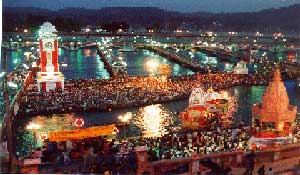A Sea of People at the River of Life

The Kumbha Mela has repeatedly been described as the largest congregation of people anywhere in the world coming together for a specific purpose. In 1989, when it was last held in Allahabad, it drew more than 15 million pilgrims.
The Kumbha Mela is held alternately in Allahabad, Haridwar, Nashik and Ujjain. The Mela is thus held at each place once every twelve years.
Allahabad is noteworthy for its location at the confluence of three sacred rivers: the Ganges, Yamuna and Saraswati. The Saraswati River is believed to be running underground.
The Legend
The earliest account of a Kumbha Mela dates from around AD 1500, though the general belief is that the festival goes back to the dawn of the universe. The Kumbha Mela is connected with the legend of the churning of the Ocean of Milk.
When the devas (gods) and asuras (demons) churned the Ocean of Milk, many wondrous things came out of it. One of them was a golden pot of amrita, the nectar of immortality. The asuras ran away with the pot, and the devas went in pursuit. During the chase, amrita from the pot spilled out and fell at four places – Allahabad, Haridwar, Nashik and Ujjain.
The chase to retrieve the pot of amrita lasted for twelve celestial days, or twelve human years. Hence, the twelve-year intervals of the Mela. The Kumbha Melas are held to coincide with the times when the amrita fell to earth. People try to bathe at the auspicious time and at the precise spots where the amrita fell, in order to obtain punya (spiritual merit).
The Rituals
In January 2001, the Kumbha Mela. was held under a special conjunction of various planetary positions which occurs only once in 144 years.
Acts of charity, the performance of pujas and special homas during the Mela are considered highly meritorious. Pujas, homas, and other spiritual practices like the chanting of mantras have a special significance and were conducted simultaneously at different places at the Kumbha Mela.
There are a few specific dates which are particularly auspicious for taking the ritual bath. Of these, three are particularly special, and are designated as the dates of shahi snan, or royal bath.
It is called a royal bath because the sadhus will be honoured like kings on these days. On shahi snan days the akharas, or sects of sadhus, lead the way to the bathing ghats. Following them is a grand procession of decorated elephants and horses, and miles of jostling pilgrims. It is a procession of great fervour, with the people chanting, shouting religious slogans, and singing devotional songs.
The number of bathers is highest on these days. People wait for hours for their turn to bathe. Many thousands wait for the most auspicious time when the rush to take a dip is the greatest. Up to two or three million people come to the bathing ghats on shahi snan days. While this number is overwhelming, the number of people who take the holy dip on the main bathing day goes up to ten million
